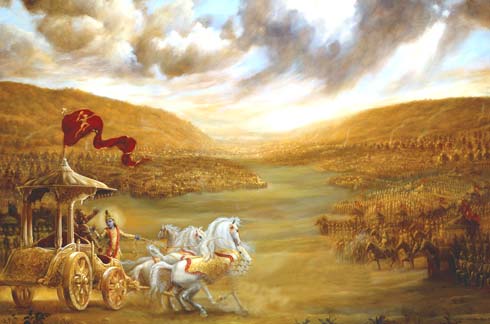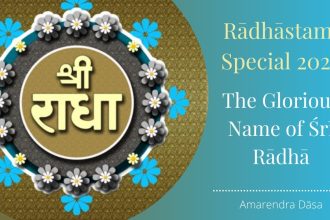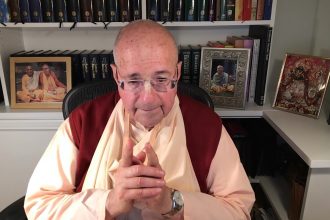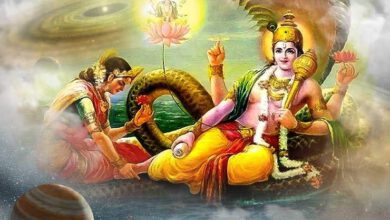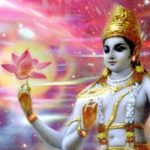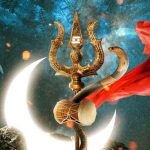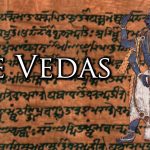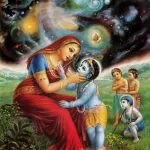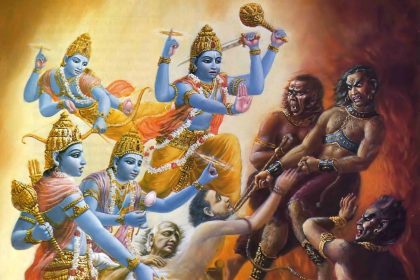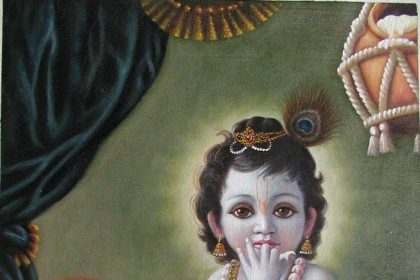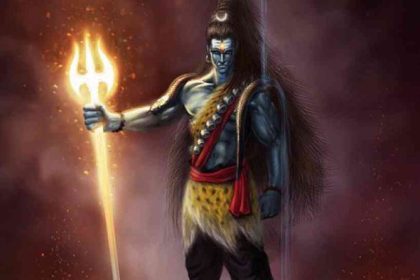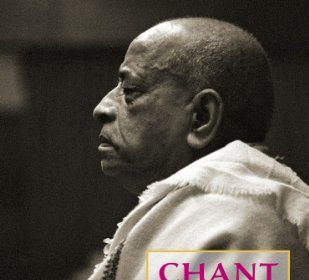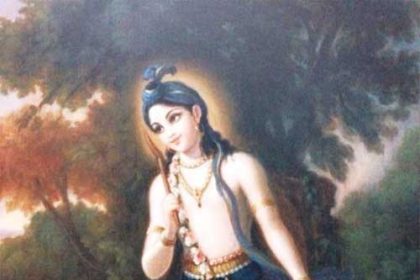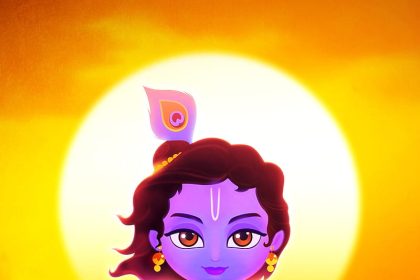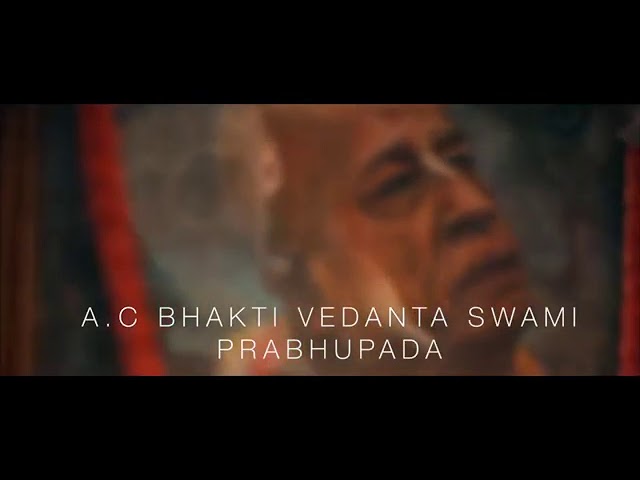- On Ekadashi, can we offer the Deity grains?
- Mahaprasad on Ekadashi
- Dvadashi
- Ekadashi Morning Meditation on the Lord
- FAQ’s on Ekadashi
- Ekadashi-Dwadasi Supreme of all Vratas
Srila A. C. Bhaktivedanta Swami Prabhupada makes an interesting comment in his purport to Sri Caitanya Caritamrta Madhya lila. 9-24-342: “You should recommend the avoidance of mixed Ekadashi and the performance of pure Ekadasi. You should also describe the fault in not observing this. One should be very careful as far as these items are concerned. If one is not careful, one will be negligent in executing devotional service.”
The Hari-bhakti-vilasa gives many rules for observing Ekadashi …, and these are discussed at length in Volume II of Pancharata-Pradipa. Here, however, we will mention only a few points concerning Ekadashi in relation to general standards of Deity worship in ISKCON: In a conversation, Srila Prabhupada said that grains should not be offered to either the spiritual master or Lord Caitanya and His associates on Ekadashi

Devotee: On Ekadashi, can we offer the Deity grains?
Prabhupada: Oh, yes. But not guru. Ekadashi is observed by jiva-tattva, not by Vishnu. We are fasting for clearing our material disease, but Radha-Krishna, Caitanya Mahaprabhu . . . Caitanya Mahaprabhu also may not be offered grains because He is playing the part of a devotee. Only Radha-Krishna, Jagannatha can be offered grains. Otherwise, Guru-Gauranga, no.
And the prasad should not be taken by anyone. It should be kept for the next day. [Srila Prabhupada Room Conversation, Tokyo, April 22, 1972] If there is only one plate for all Deities and the main Deity is Krishna or Jagannatha, grains should be offered as on normal days. If the main Deities are Gaura-Nitai, offer only non-grain preparations.* It is best to replace the normally offered grain preparations with non-grain preparations so that there are the same number of preparations as on normal days.
If, however, grain preparations are being cooked for Krishna or Jagannatha, it may be difficult to cook additional non-grain preparations for the spiritual master and Gaura-Nitai. In that case serve larger quantities of the non-grain preparations to the spiritual master and Gaura-Nitai, and prepare the offering plate for Krishna or Jagannatha as on normal days. If you are cooking for a restaurant where grains will be served on Ekadashi , you may offer the grains to Gaura-Nitai with the understanding that they will offer the bhoga to Krishna. What Constitutes “Grains” on Ekadashi? Srila Prabhupada specified foodgrains and beans (pulses) as foods that must be avoided on Ekadashi.
One may use spices for cooking, although mustard seeds should be avoided. You should not use powdered asafatoeda (hing), since it (generally) contains grains. Sesame seeds are also to be avoided, except on Satila Ekadashi, when they may be offered and eaten. Do not use any cooking ingredients that might be mixed with grains, such as ghee that has been used to fry puris, or spices touched by hands dusted with chapati flour. There is absolutely NO doubt about what is NOT permissible to eat on Ekadashi. ANNA.
However it is how you translate this word that makes the difference. I once again submit what Pradyumna Prabhu told me Srila Prabhupada told him many years ago. When asked by Pradyumna what we could eat Srila Prabhupada said “Fruits, Roots, Nuts, Milk”. If you stick to these types of foods you should be fine. Of course the sure way is to fast completely. Water of course can be taken. Except if you wish to do Nirjala.
Someone who is very strictly observing Ekadashi should avoid all spices except pepper, rock salt and cumin. He should also eschew certain vegetables, such as tomatoes, cauliflower, eggplant, and leafy vegetables. Temple kitchens need not follow these strictures, since Srila Prabhupada did not establish them. Individual devotees may observe these rules if they choose, either making their own arrangements for cooking on Ekadashi, eating uncooked foods such as fruit, or observing full fasting. These arrangements should not interfere with the temple cooking schedule.
Mahaprasad on Ekadashi 🔝
Strict followers of Vaishnava regulations avoid eating any mahaprasad from an offering that includes grains. The shastra explains that the papa-purusha (sin personified) takes shelter in grains on Ekadashi , and therefore we avoid grains at all cost on that day, not even risking taking non-grain preparations of mahaprasad from an offering plate containing grains. Ekadashi mahaprasad should be stored until the next day; if that is not possible it can be distributed to persons not strictly following Vaishnava regulations or to animals. In fact, mahaprasad maintains its purity on Ekadashi despite the presence of the papa-purusha, and therefore it will purify anyone who eats it. Nevertheless, the followers of Caitanya Mahaprabhu, being strict followers of Vaishnava regulations, avoid mahaprasad on that day because their strict sadhana will be hampered by the presence of the papa-purusha
Dvadashi 🔝
The day after Ekadashi – the day of breaking the Ekadashi Fast (To observe Ekadashi properly, one should strictly observe the breaking of this fast.) One should break the fast after the sunrise of the dvadasi, after the first quarter of the dvadashi tithi has passed, but before the dvadashi tithi has ended. After taking morning bath, one should offer the upavasa to the Lord:
ajnana timirandhasya vratenanena kesava
prasida sumukho natha jnana drsti bhava
“Oh Kesava, be pleased with this vrata performed by one fallen in the modes of darkness. Oh Lord, bestow your glance of knowledge upon me.”
One should observe similar rules as on dashami. For health and common sense, what to speak of spiritual development, it is wise to eat only once going into a fast and coming out of a fast. The meal should also be light. From an Ayurvedic perspective, especially if one is fasting entirely, or even just taking water, the malas (stools) absorb the toxins in the body when fasting. So on the day the fast is broken it is a good idea to take a gentle laxative consisting of 50-50 warm milk and water, with some rock candy to sweeten it. Generally 4-5 cups are drunk (up to 7) and within half an hour to an hour one will expel the malas. After this at lunch time one takes one’s meal of prasadam. One should not bathe the deity on the dvadashi day, but bathe the Lord in ghee in the night. But if one does, then it should be performed before sunrise. Mahadvadasi: Sometimes, due to the manner in which the Ekadashi tithi and the dvadashi tithis are positioned in relation to the sunrise (there are six different cases), the vrata is observed on the dvadashi and the fast is broken the next day, the trayodashi. Such a fast day is called a mahadvadashi, to distinguish it from a regular dvadashi, which is the day to break the Ekadashi fast.
Ekadashi Morning Meditation on the Lord 🔝
- Lotus Feet: Om Damodaraya Namah
- Thighs: Om Madhavaya Namah
- Private Parts: Om Kamapataye Namah
- Hips: Om Vamanaya Namah
- Navel: Om Padmanabhaya Namah
- Stomach: Om Vishvamutaye Namah
- Heart: Om Jnanagamyaya Namah
- Throat: Om Srikanthaya Namah
- Arms: Om Sahasrabahave Namah
- Lotus Eyes: Om Paramayogine Namah
- Forehead: Om Urugayai Namah
- Nose: Om Narakeshvaraya Namah
- Hair: Om Sarvakamadaya Namah
- Head: Om Sahasrashirshaya Namah
FAQ’s on Ekadashi 🔝
The importance of Ekadashi for worshippers of Sriman Narayana cannot be emphasized enough. Ekadashi is also called “ Hari-Vasara” (Lord Hari’s day).All our elders have steadfastly observed the Ekadashi-Dwadasi vratam or “Upavasam” on this sacred day. Upa means near and Vasam means stay. Stay close to Hari contemplating on His kalyana gunas. This is the summum bonum of Ekadashi vratam.
Do we need to fast on Ekadashi? Since upavasam does not (directly) connote fasting, a question may be asked as to the need to fast on Ekadashi. Shastras give unequivocal answers. The following quotes from our shastras should clear any doubts in this regard:
ekadashyam tu yo bhunkte mohenavritachetasah
shuklayamatha krishhnayam nirayam yati sa dhruvamah
One who eats on Ekadashi on account of an intellect clouded by delusion; be it the shukla-paksha, or the krishhna-paksha, (s)he goes to hell, this is certain. ashhtavarshhadhiko yastu ashItirnahi puryate yo bhunkte manavah papo vishhnorahani chagate One who is greater than eight years of age, but has indeed not completed eighty; the human who eats when Vishnu’s day arrives, consumes verily sin itself. In addition, several scientific findings go to prove the benefits of fasting on one’s health. This should further reinforce one’s determination to fast.
When should one observe fast – When to observe Ekadashi-Vratam? 🔝
Sometimes Ekadashi can be combined with Dasami or Dwadasi. It appears that shastras are strict concerning the observance of vratam. If on a day if both Dasami and Ekadashi are present that day must be avoided and the fasting should be observed the following day. Here is what shastras tell us:
kalavedhe tu viprendra dashamyaikadashi yadi
suraya binduna sprishhtam gangambha iva santyajetah
If there is even the slightest contact of dashami with Ekadashi; then as with Ganga-water that has a drop of liquor mixed in it, such is to be rejected. Therefore, the “pollution” of contact with another date is so great that even a small amount of it would render the observance worthless
ekadashya yada brahmanah dinaxayatithir bhavetah
uposhhya dvadashi punya trayodashyam tu paranamah
If on the day of Ekadashi adinaksaya-tithi (incomplete date) occurs; then fasting is to be undertaken on dvadashi, and parane on the trayodashi Therefore, such a situation merely re-schedules the observance, and does not excuse it.
bahvagamavirodheshu brahmaneshhu vivadishhu
Buposhhya dvadashI punya paxayorubhayorapi |
When there is a conflict between different almanacs, and when the brahmana’s disagree [on Ekadashi]; fast then on the pious dvadashi, in either fortnight (i.e., in the waxing or the waning of the moon). Therefore, when there is conflict among various texts and when one is unable to decide when the correct Ekadashi is, one must fast instead on the dvadashi day that follows.
How to break your fast on Dwadasi? 🔝
Timely breaking of the fast on Dwadasi is as important as observing the fast on Ekadashi. Normally, the fast must be broken before trayodasi arrives. If there is insufficient time, the fasting can be broken with water. From the Shastras we find: parayitvodakenapi bhunjjano naiva dushyati
ashitanashita yasmadapo vidvadbhiriritah ambhasa kevalenaiva karishhye vrataparanamah
If there is insufficient time there is no flaw if water is consumed for parane; for it is stated by the learned that water has the property that when consumed, it is still as if one has not consumed; thus, with only water, do I perform the ceremonial parane. If there is not enough time for a proper parane, then the fast may be broken merely by sipping water; there is no flaw of multiple parane’s on this account, as the wise have decreed that such a procedure does not count as multiple parane’s. Having performed the ceremonial parane in this manner, one may have a proper meal later, although the time later may not be appropriate for parane itself.
dvadasha na pramoktavya yavadayua pravartate archaniyo hrishhikesho vishuddhenantaratman
The dvadashi is not to be neglected, as long as life goes on; Hrshikesha is to be worshipped [for so long] with a clean psyche. Concerning the food for Dwadasi parane, one should avoid using anything related to plantains (unripe banana,leaves etc.), also avoid chilies and tamarind. One can substitute pepper for chilies and lemon or dry mango powder for tamarind. Include sundaikay,amla (nellikay), and akathik keeraiy (a kind of spinach).
Why not other days? Why only on Ekadashi? 🔝
From time immemorial, Vaishnavas have been observing fasts twice a month on Ekadashi days. This fasting is, in general, for everyone. Ekadashi is the 11th day in the moon cycle, i.e. from the new moon day and also from the full moon day. It is a proven scientific matter that the air pressure in the atmosphere rapidly changes in the surroundings on a full moon day or on the new moon day. The sun-moon-earth combination in the orbital path, when distances itselves at every particular interval, (i.e. every 24 Hrs or for every full circle the earth rotates). When it occurs, accordingly pressure in atmosphere too changes and varies. One can observe this from the increasing high tidal waves in the ocean. On any given New moon day or Amavasya the pressure increases in the ocean and the tidal waves are very rough and high..
But from the next day onwards the pressure recedes gradually thus proving that the atmospheric pressure too reduces. So, practically on the 11th day from new/full moon days, the pressure is somewhat very light or nil. If one has to go with an empty stomach on any other day the atmospheric pressures will put on him or her more strain wherein on the Ekadashi day the problem is minimal or nil. So the body never takes the pain while we cleanse the bowel system and thus refreshing the whole body mechanism, specifically the liver-stomach-bowel and the system movements. But on the immediate next day (called Dwaadasi or Dvadasi – i.e. 12th day from full/new moon), to avoid any pressure on the body system, Srivaishnavites used to eat food in the morning as early as possible. Thus avoiding any system collapse. So it is advisable to observe fasting only on the Ekadashi day and to give scope for refreshing the body mechanism. But one must eat food immediately the next morning to avoid any complications.
As the atmospheric pressure builds up faster and doubly on the 12th day from Amavasya & Poornima days, it is strongly recommended to consume food on the Dwadasi day in the early morning. Those who observe on Ekadashi days are keeping fittest health, cleansing their bowel system and mostly free from frequent ailments. Also, those who are the Bhakta’s of Lord Krishna, observing fasting on Ekadashi days, have lot more mental peace, by way of self realization and inner soul! That reflects them to more and more devote to the spiritual path! Yes, this sort of penance also give them a more stronger feeling towards spirituality, thus making them pure in body and mind.
Ekadashi-Dwadasi Supreme of all Vratas 🔝
There is a saying that: “ Na Dwadasyat param Vratam ”. Therefore observing the Ekadashi-Dwadasi vratam is equivalent to performing many Yagnyas. Most of us are familiar with the story of Ambarisha. What’s more, one becomes dear to our Lord Narayana.
Ekadashisamutthena vahnina patakendhanamah
bhasmibhavati rajendra api janmashatodbhavamah
With the Ekadashi as fire, and sin as fuel; [the latter] gets incinerated, O King, even if it be obtained of hundreds of lifetimes (From Bhaghavatam). Therefore, while other actions can bring some benefits, none of them quite matches up to the power of an Ekadashi in terms of removing the accumulation of sins, which brings one misery.
From Sri Ekadashi Mahatmya


